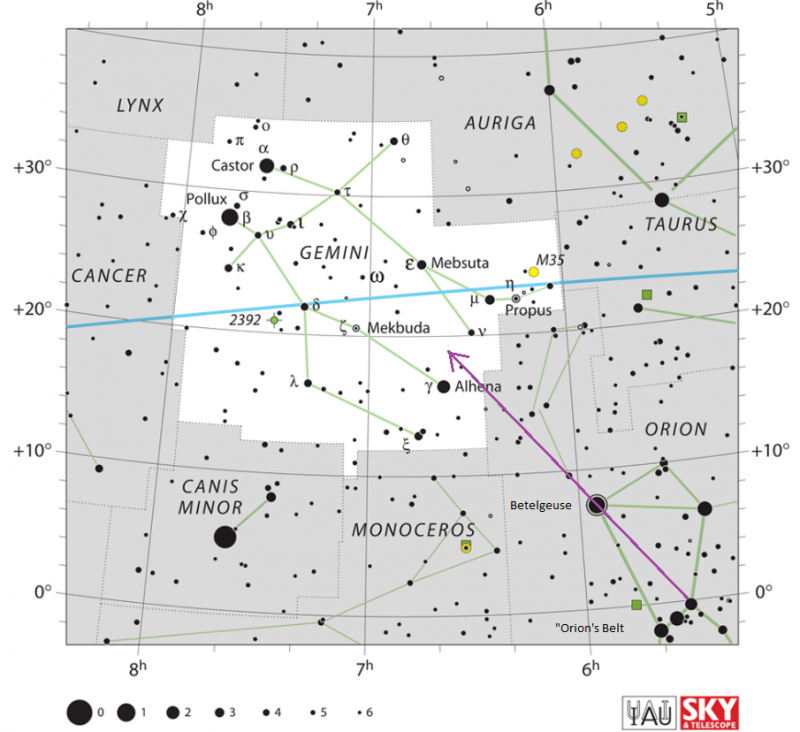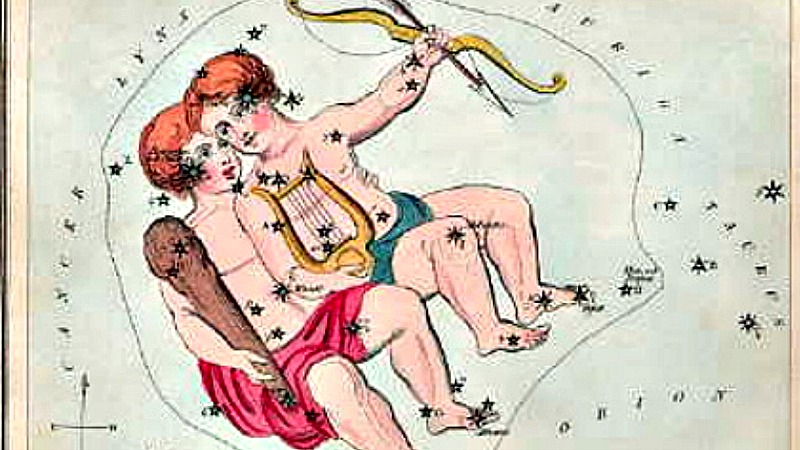
On the evenings of February 6 and 7, 2020, the waxing gibbous moon is bright enough to erase many stars from the blackboard of night. But you’ll likely still see the two bright Gemini “twins” – the stars Castor and Pollux – in the moon’s glare. Another bright star is nearby; it’s Procyon, brightest star in the constellation Canis Minor the Lesser Dog, also known as the Little Dog Star.
The dark side of a waxing moon always points in its direction of travel around Earth – eastward – in front of the backdrop stars. As Earth spins under the sky, the stars, planets and moon all appear to shift westward throughout the night. Meanwhile, the moon’s orbital motion is carrying it eastward through the constellations of the zodiac … and through Gemini on these two nights.
Visit Heavens-Above to know the moon’s place upon the zodiac.
Look for the moon and constellation Gemini to reach their high point for the night somewhere around 10 p.m. local time. That’s the approximate time on your clock, no matter where you live around the globe.
Every month, the moon in its journey in front of the constellations of the zodiac always travels to the south of the Gemini stars, Castor and Pollux, and to the north of the Little Dog star Procyon. In fact, an imaginary line drawn from Procyon and going in between Castor and Pollux takes you to Polaris, the North Star, although it’s a mighty long jump from Procyon to Polaris. You have to be in the Northern Hemisphere to see Polaris in your sky, otherwise this star sits beneath your horizon.
Visit Stellarium for an interactive sky chart.
Are you in the Southern Hemisphere? The moon passes between the Gemini stars and Procyon once a month for you, as well. Around mid-evening, people at temperate latitudes in the Southern Hemisphere will see the moon, Gemini stars and Procyon in their northern evening sky. At mid-evening, we in the Northern Hemisphere will see all of these objects more south to overhead.
From the vantage point of either hemisphere, the other hemisphere sees things upside down. Up or down is a matter of perspective. To avoid ambiguity, we can say that Castor and Pollux lie north of the moon (in the direction of the North Star), and Procyon lies south of the moon (away from the North Star).

Sky chart of the constellation Gemini via IAU. When the moon is no longer in front of Gemini, draw an imaginary line from the easternmost star of Orion’s Belt and through the bright ruddy star Betelgeuse to locate the Gemini stars, Castor and Pollux.

The 2 bright stars of Gemini – Castor and Pollux – are often depicted as marking a starry eye of a Twin. If you have binoculars and a dark sky, be sure to check out Gemini’s beautiful star cluster, Messier 35, or M35, in western Gemini near the Taurus border. See it, at the foot of Castor?

Castor and Pollux, the Gemini twins, via Wikipedia.
Bottom line: On the nights of February 6 and 7, 2020, watch the moon pass to the south of the Gemini stars and to the north of Procyon.
EarthSky astronomy kits are perfect for beginners. Order today from the EarthSky store
Want more about Gemini? Here’s your constellation
from EarthSky https://ift.tt/31tfS3i

On the evenings of February 6 and 7, 2020, the waxing gibbous moon is bright enough to erase many stars from the blackboard of night. But you’ll likely still see the two bright Gemini “twins” – the stars Castor and Pollux – in the moon’s glare. Another bright star is nearby; it’s Procyon, brightest star in the constellation Canis Minor the Lesser Dog, also known as the Little Dog Star.
The dark side of a waxing moon always points in its direction of travel around Earth – eastward – in front of the backdrop stars. As Earth spins under the sky, the stars, planets and moon all appear to shift westward throughout the night. Meanwhile, the moon’s orbital motion is carrying it eastward through the constellations of the zodiac … and through Gemini on these two nights.
Visit Heavens-Above to know the moon’s place upon the zodiac.
Look for the moon and constellation Gemini to reach their high point for the night somewhere around 10 p.m. local time. That’s the approximate time on your clock, no matter where you live around the globe.
Every month, the moon in its journey in front of the constellations of the zodiac always travels to the south of the Gemini stars, Castor and Pollux, and to the north of the Little Dog star Procyon. In fact, an imaginary line drawn from Procyon and going in between Castor and Pollux takes you to Polaris, the North Star, although it’s a mighty long jump from Procyon to Polaris. You have to be in the Northern Hemisphere to see Polaris in your sky, otherwise this star sits beneath your horizon.
Visit Stellarium for an interactive sky chart.
Are you in the Southern Hemisphere? The moon passes between the Gemini stars and Procyon once a month for you, as well. Around mid-evening, people at temperate latitudes in the Southern Hemisphere will see the moon, Gemini stars and Procyon in their northern evening sky. At mid-evening, we in the Northern Hemisphere will see all of these objects more south to overhead.
From the vantage point of either hemisphere, the other hemisphere sees things upside down. Up or down is a matter of perspective. To avoid ambiguity, we can say that Castor and Pollux lie north of the moon (in the direction of the North Star), and Procyon lies south of the moon (away from the North Star).

Sky chart of the constellation Gemini via IAU. When the moon is no longer in front of Gemini, draw an imaginary line from the easternmost star of Orion’s Belt and through the bright ruddy star Betelgeuse to locate the Gemini stars, Castor and Pollux.

The 2 bright stars of Gemini – Castor and Pollux – are often depicted as marking a starry eye of a Twin. If you have binoculars and a dark sky, be sure to check out Gemini’s beautiful star cluster, Messier 35, or M35, in western Gemini near the Taurus border. See it, at the foot of Castor?

Castor and Pollux, the Gemini twins, via Wikipedia.
Bottom line: On the nights of February 6 and 7, 2020, watch the moon pass to the south of the Gemini stars and to the north of Procyon.
EarthSky astronomy kits are perfect for beginners. Order today from the EarthSky store
Want more about Gemini? Here’s your constellation
from EarthSky https://ift.tt/31tfS3i

Aucun commentaire:
Enregistrer un commentaire